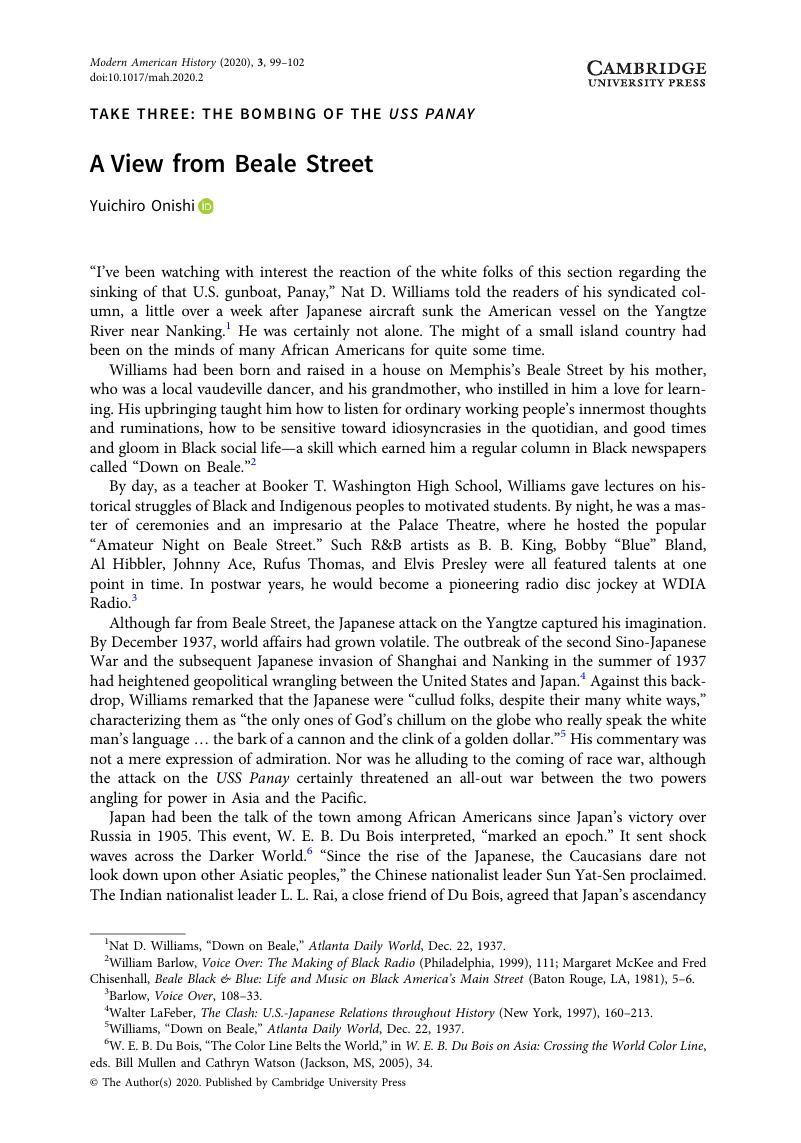No CrossRef data available.
Article contents
A View from Beale Street
Published online by Cambridge University Press: 16 March 2020
Abstract

Keywords
- Type
- Take Three: The Bombing of the USS Panay
- Information
- Copyright
- Copyright © The Author(s) 2020. Published by Cambridge University Press
References
1 Nat D. Williams, “Down on Beale,” Atlanta Daily World, Dec. 22, 1937.
2 Barlow, William, Voice Over: The Making of Black Radio (Philadelphia, 1999), 111Google Scholar; McKee, Margaret and Chisenhall, Fred, Beale Black & Blue: Life and Music on Black America's Main Street (Baton Rouge, LA, 1981), 5–6Google Scholar.
3 Barlow, Voice Over, 108–33.
4 LaFeber, Walter, The Clash: U.S.-Japanese Relations throughout History (New York, 1997), 160–213Google Scholar.
5 Williams, “Down on Beale,” Atlanta Daily World, Dec. 22, 1937.
6 Du Bois, W. E. B., “The Color Line Belts the World,” in W. E. B. Du Bois on Asia: Crossing the World Color Line, eds. Bill Mullen and Cathryn Watson (Jackson, MS, 2005), 34Google Scholar.
7 Du Bois, “The Color Line Belts the World,” 34; Deutsch, Nathaniel, “‘The Asiatic Black Man’: An African American Orientalism?” Journal of Asian American Studies 4, no. 3 (Oct. 2001): 194–5CrossRefGoogle Scholar; Horne, Gerald, The End of Empires: African Americans and India (Philadelphia, 2008), 67–78Google Scholar; Horne, Gerald, Facing the Rising Sun: African Americans, Japan, and the Rise of Afro-Asian Solidarity (New York, 2018), 25–40CrossRefGoogle Scholar.
8 Perry, Jeffrey B., Hubert Harrison: The Voice of Harlem Radicalism, 1883–1918 (New York, 2009)Google Scholar; Onishi, Yuichiro, “The New Negro of the Pacific: How African Americans Forged Solidarity with Japan,” in Escape from New York: The New Negro Renaissance, eds. Baldwin, Davarian L. and Makalani, Minkah (Minneapolis, 2013), 127–9CrossRefGoogle Scholar.
9 Kaplan, Amy, The Anarchy of Empire in the Making of U.S. Culture (Cambridge, MA, 2002), 12–4, 171–212Google Scholar; Williams, Chad L., Torchbearers of Democracy: African American Soldiers in the World War I Era (Chapel Hill, NC, 2010), 27–8, 246Google Scholar.
10 Harrison, Hubert, “The Washington Conference,” Negro World 11 (Nov. 19, 1921)Google Scholar, in A Hubert Harrison Reader, ed. Perry, Jeffrey B. (Middletown, CT, 2001), 230–1Google Scholar.
11 Allen, Ernest Jr., “When Japan Was ‘Champion of the Darker Races’: Satokata Takahashi and the Flowering of Black Messianic Nationalism,” The Black Scholar 24, no. 1 (1994): 23–46CrossRefGoogle Scholar; Ernest Allen, Jr., “‘Waiting for Tojo: The Pro-Japan Vigil of Black Missourians, 1932–1943,” Gateway Heritage (1995): 38–55; Horne, Facing the Rising Sun.
12 Blain, Keisha N., Set the World on Fire: Black Nationalist Women and the Global Struggle for Freedom (Philadelphia, 2018)CrossRefGoogle Scholar; Blain, Keisha N., “‘[F]or the Rights of Darker People in Every Part of the World’: Pearl Sherrod, Black Internationalist Feminism, and Afro-Asian Politics during the 1930s,” Souls: A Critical Journal of Black Politics, Culture, and Society 17, nos. 1–2 (2015): 90–112CrossRefGoogle Scholar; Horne, Facing the Rising Sun, 57–93; Hill, Robert A., “Dread History: Leonard P. Howell and Millenarian Visions in Early Rastafari Religions,” The Beat 3, no. 4 (Aug. 1984): 19Google Scholar. On the distinct Black religious experience, see Weisenfeld, Judith, New World A-Coming: Black Religion and Racial Identity during the Great Migration (New York, 2016)Google Scholar.
13 Horne, Facing the Rising Sun, 94–111; Allen, “When Japan Was ‘Champion of the Darker Races’”; Allen, “‘Waiting for Tojo.”
14 Jones, Andrew F. and Singh, Nikhil Pal, “Guest Editors’ Introduction,” positions: east asia cultures critique 11, no. 1 (2003): 7CrossRefGoogle Scholar.
15 Bassett, Theodore, Berry, A. W., Briggs, Cyril, Ford, James W., and Haywood, Harry, Is Japan the Champion of the Colored Races? (New York, 1938)Google Scholar, https://nmaahc.si.edu/object/nmaahc_2010.55.9 (accessed Dec. 9, 2019).
16 Williams, “Down on Beale,” Atlanta Daily World, Aug. 29, 1936.
17 Williams, “Down on Beale,” Atlanta Daily World, Dec. 22, 1937.
18 Ibid.


